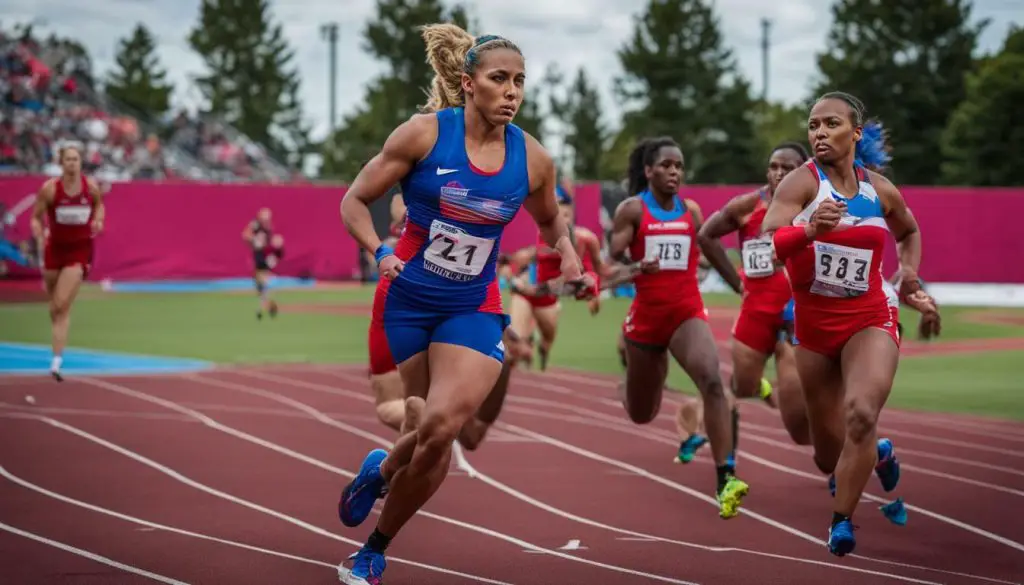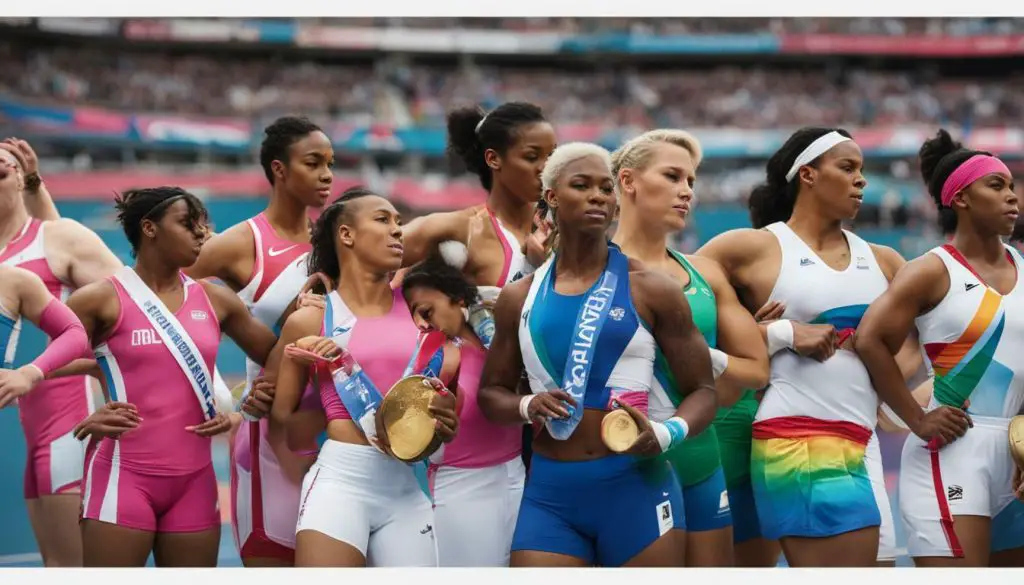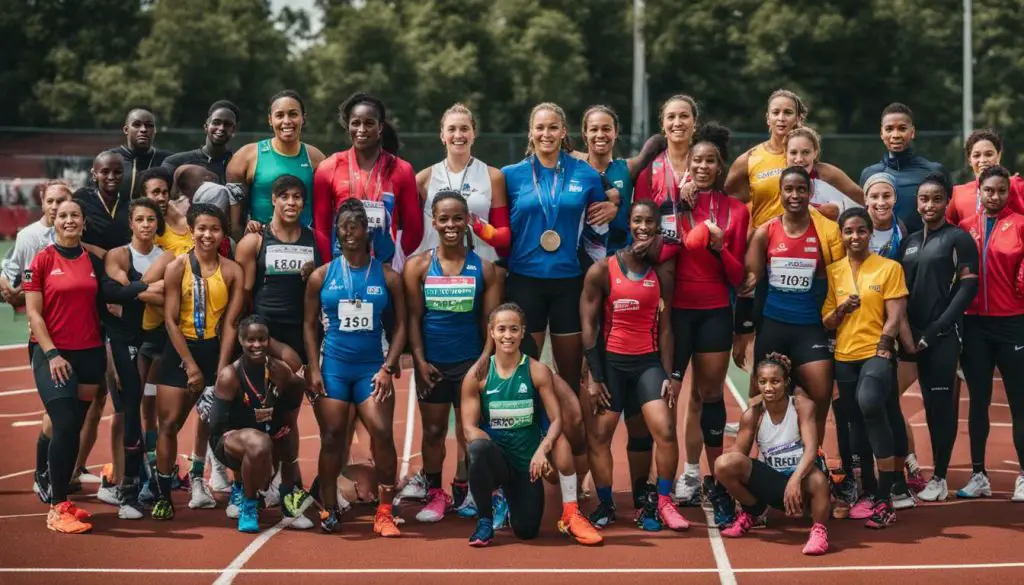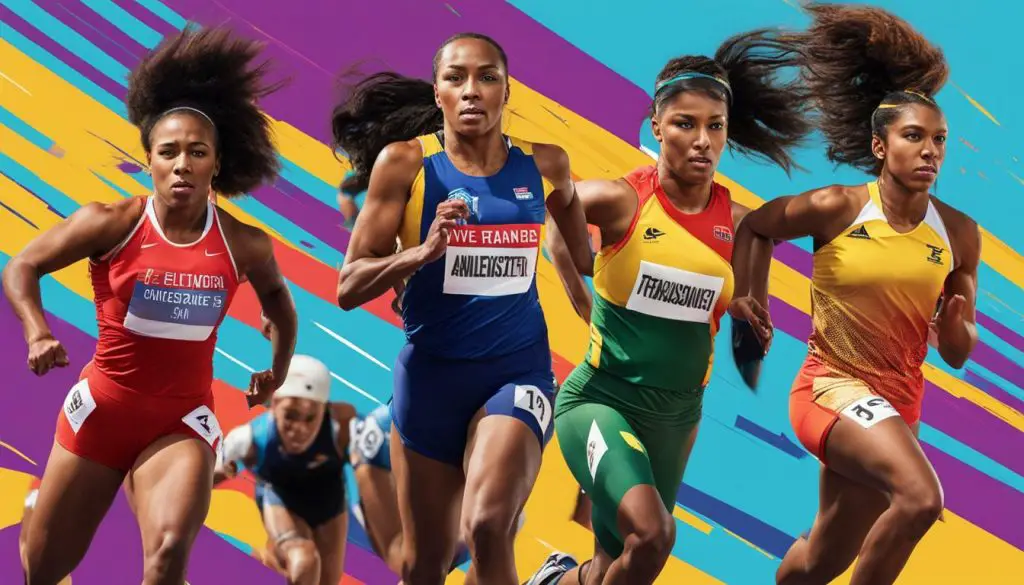Transgender athletes face challenges and discrimination when it comes to participating in sports, and the rules governing their inclusion in American sports can vary. It is an issue that has sparked debates and controversies in recent years, with differing opinions on gender identity and rights in the context of sports.
Despite the challenges they face, transgender athletes continue to strive for equal opportunities in sports competition. They seek to participate in sports alongside their cisgender counterparts, contributing their skills and talents to their respective teams.
Transgender athletes policy and transgender sports rules are essential in ensuring fair and inclusive competition. These guidelines, set by sports organizations and governing bodies, seek to address the eligibility of transgender athletes to compete while considering factors such as hormonal therapy and gender affirmation surgery.
Supporters of transgender inclusion in sports argue that denying transgender individuals the right to compete goes against principles of inclusivity and equality. They advocate for creating safe and supportive environments that allow transgender athletes to excel and pursue their sporting passions.
However, there is also opposition to transgender athletes’ participation in sports. According to a Gallup survey, a majority of people believe that transgender athletes should only be allowed to compete on teams that align with the sex they were assigned at birth. This opposition may stem from a lack of personal connection or understanding of transgender individuals.
The World Athletics Council recently made a decision to bar transgender women athletes from elite competitions for women, citing concerns of fairness and integrity. This decision aligns with the growing resistance against transgender women and girls participating in female sports, as seen in the decisions made by other sports governing bodies and the introduction of anti-transgender legislation in the U.S.
As the conversation around transgender inclusion in sports continues, it is essential to consider a balanced approach that respects both fairness and inclusivity. It is crucial to gather perspectives from transgender athletes themselves and ensure that their rights and experiences are taken into account when making decisions that impact their participation in sports.
The Controversy Surrounding Transgender Athletes in Sports
The participation of transgender athletes in sports has sparked a heated controversy, with debates centered around gender identity, rights, and fairness. Advocates argue that inclusivity and equal opportunities should be extended to transgender individuals, allowing them to compete in sports based on their identified gender. They believe that everyone should have the right to participate and excel in the sports they love, regardless of their gender identity.
However, opponents raise concerns about the potential advantages that transgender athletes may have over their cisgender counterparts. They argue that biological differences between males and females, such as muscle mass and testosterone levels, could give transgender women an unfair advantage in women’s sports. Critics also worry that allowing transgender athletes to compete according to their gender identity could potentially jeopardize the integrity of women’s sports.
“These restrictions on transgender inclusion in sports align with a growing resistance against transgender women and girls participating in female sports, as seen in the decisions made by other sports governing bodies and the introduction of anti-transgender legislation in the U.S.”
World Athletics Council has also decided to bar transgender women athletes from elite competitions for women, citing fairness and integrity. The council plans to form a working group to consider the issue of transgender inclusion and gather perspectives from transgender athletes. There is limited scientific research on the advantages or disadvantages of transgender women athletes, but the council says they have conducted their own research over the past decade.

It is crucial to approach this controversy with sensitivity and respect for all individuals involved. While concerns about fairness and maintaining a level playing field in sports are valid, it is equally important to consider the rights and inclusion of transgender athletes. Striking a balance that addresses both concerns is essential to ensure a fair and inclusive environment in sports.
| Key Points | Summary |
|---|---|
| 1. Advocates emphasize inclusivity and equal opportunities for transgender athletes. | Advocates stress the importance of allowing transgender athletes to compete based on their identified gender, ensuring equal opportunities for participation in sports. |
| 2. Critics express concerns about possible advantages and fairness. | Critics raise concerns about potential advantages transgender athletes may have over cisgender athletes, particularly in terms of biological differences and potential unfair advantages. |
| 3. World Athletics Council’s decision and ongoing research. | The World Athletics Council has decided to ban transgender women athletes from elite women’s competitions, citing fairness and integrity concerns. They plan to gather perspectives from transgender athletes through a working group. |
Current Policies and Rules for Transgender Athletes in American Sports
Various sports organizations and governing bodies have established policies and rules to address the inclusion of transgender athletes in American sports. These guidelines aim to ensure fairness, respect, and equal opportunities for all individuals, regardless of their gender identity.
One prominent policy is the guidelines set by the International Olympic Committee (IOC) in 2015. The IOC allows transgender women to compete in women’s sports, provided they meet specific criteria. These criteria include maintaining a testosterone level below a designated threshold for at least 12 months prior to the competition.
In the United States, the policies and rules for transgender athletes vary across different sports. Some sports organizations, such as the NCAA (National Collegiate Athletic Association), have implemented policies that allow transgender athletes to participate in accordance with their gender identity. The NCAA’s policy includes hormone therapy requirements for transgender women and testosterone level restrictions for transgender men.
Other sports organizations, such as USA Track and Field, have established separate categories for transgender athletes, allowing them to compete based on their gender identity. This approach acknowledges the importance of inclusion while also addressing any potential concerns regarding competitive advantages.

| Sports Organization | Policy |
|---|---|
| International Olympic Committee (IOC) | Transgender women can compete in women’s sports if they meet specific criteria, including maintaining a testosterone level below a designated threshold. |
| NCAA (National Collegiate Athletic Association) | Transgender athletes can participate in accordance with their gender identity, with hormone therapy requirements for transgender women and testosterone level restrictions for transgender men. |
| USA Track and Field | Transgender athletes can compete based on their gender identity, with separate categories established to address any potential concerns regarding competitive advantages. |
While these policies strive to create inclusive environments for transgender athletes, they continue to be subject to debate and controversy. Critics argue that transgender athletes may have physical advantages over cisgender athletes, while proponents emphasize the importance of inclusivity, fairness, and respecting individuals’ gender identities.
As the conversation around transgender inclusion in sports continues to evolve, it is crucial for sports organizations, governing bodies, and society as a whole to approach the topic with empathy, understanding, and a commitment to fair competition. By considering the perspectives of transgender athletes and engaging in ongoing dialogue, we can work towards creating an inclusive and equitable sporting environment for all individuals.
Opposition and Support for Transgender Athletes’ Participation in Sports
While there is significant support from medical associations, sports organizations, and athletes for transgender athletes’ participation in sports, there is also opposition based on various factors. According to a Gallup survey, 69% of people believe that transgender athletes should only be allowed to compete on teams that align with the sex they were assigned at birth. However, it is important to note that public opinion on this issue varies, with younger adults being generally more supportive of trans people and their inclusion in sports.
Opponents of transgender athletes’ participation in sports often highlight concerns about fairness and competitive advantage. They argue that allowing trans women (assigned male at birth) to compete in women’s sports could potentially give them physical advantages due to inherent biological differences. However, it is crucial to recognize that transgender athletes’ abilities and performances can vary greatly, just like any other athletes. The notion that all transgender athletes have an unfair advantage is not supported by scientific research or empirical evidence.
It is also worth mentioning that attacks on transgender youth in sports are not based on factual data. In 2021 alone, over 55 anti-transgender bills were directly aimed at transgender girls and women in sports. These bills perpetuate discrimination against transgender individuals and seek to restrict their access to gender-affirming medical care. However, there is no evidence to support the claims made by proponents of these bills. Transgender athletes are a small part of the overall population and have varying abilities, interests, and levels of commitment to sports, just like any other youth.
“These attacks on transgender youth are fueled by discrimination, not facts.”
The discrimination faced by transgender athletes has prompted organizations, medical associations, and prominent athletes to voice their support for trans people’s participation in sports. They emphasize the importance of inclusivity, equality, and providing transgender athletes with equal opportunities to compete and excel in their chosen sports. However, despite the growing support, it is evident that opposition still exists, fueled by a lack of personal connection to transgender individuals and misconceptions about their abilities.

| Opposition | Support |
|---|---|
|
|
World Athletics Council’s Decision and Growing Resistance
The World Athletics Council’s decision to restrict transgender women athletes from elite women’s competitions is part of a broader resistance against transgender inclusion in sports, as seen in various sports governing bodies’ actions and the introduction of anti-transgender legislation. In 2021, there were 27 anti-LGBTQ+ bills enacted, with over 55 directly targeting transgender girls and women in sports. Some of these bills aim to restrict transgender youth from accessing gender-affirming medical care.

However, there is no evidence to support the claims made by proponents of these bills. Transgender athletes are a small part of the overall population and have varying abilities, interests, and levels of commitment to sports, just like any other youth. These attacks on transgender youth are fueled by discrimination, not facts.
Sports organizations, medical associations, and prominent athletes have spoken out in support of trans people’s participation in sports. However, according to a Gallup survey, 69% of people believe that transgender athletes should only be allowed to compete on teams that align with the sex they were assigned at birth. This opposition may be due to a lack of personal connection to trans individuals. Young adults are generally more supportive of trans people and their inclusion in sports.
The World Athletics Council’s decision reflects a broader trend in the resistance against transgender women and girls participating in female sports. Other sports governing bodies have made similar decisions, further limiting the opportunities for transgender athletes to compete. Additionally, anti-transgender legislation has been introduced in the United States, further exacerbating the challenges faced by transgender individuals in sports.
The council plans to form a working group to consider the issue of transgender inclusion and gather perspectives from transgender athletes. While there is limited scientific research on the advantages or disadvantages of transgender women athletes, the council states that they have conducted their own research over the past decade.
In conclusion, the World Athletics Council’s decision and the growing resistance against transgender inclusion in sports highlight the ongoing challenges and discrimination transgender athletes face. It is crucial to foster a balanced approach that considers both fairness and inclusivity in the participation of transgender athletes in sports.
| Key Points: |
|---|
| – The World Athletics Council’s decision to restrict transgender women athletes from elite women’s competitions |
| – The broader resistance against transgender inclusion in sports |
| – Anti-transgender legislation and discriminatory efforts targeted at transgender youth in sports |
| – Support from sports organizations, medical associations, and prominent athletes |
| – The need for a balanced approach that considers both fairness and inclusivity in transgender athletes’ participation in sports |
“Transgender athletes are a small part of the overall population and have varying abilities, interests, and levels of commitment to sports, just like any other youth. These attacks on transgender youth are fueled by discrimination, not facts.” – American Association of Pediatrics
Related Articles:
- “The Challenges Faced by Transgender Athletes in Today’s Sports”
- “The Impact of Anti-Transgender Legislation in Sports”
Conclusion
The inclusion of transgender athletes in sports is a complex and controversial issue that requires careful consideration of fairness, inclusivity, and respect for the rights of all individuals involved. Transgender athletes face challenges and discrimination when it comes to participating in sports, with numerous anti-LGBTQ+ bills targeting transgender girls and women enacted in 2021. These bills seek to restrict transgender youth from accessing gender-affirming medical care, despite the lack of evidence to support the claims made by proponents.
It is important to recognize that transgender athletes are a small part of the overall population, each with varying abilities, interests, and levels of commitment to sports, just like any other youth. The attacks on transgender youth in sports are fueled by discrimination, rather than facts. However, there is strong support for trans people’s participation in sports from sports organizations, medical associations, and prominent athletes.
A Gallup survey revealed that 69% of people believe transgender athletes should only be allowed to compete on teams that align with the sex they were assigned at birth. This opposition may stem from a lack of personal connection to transgender individuals. However, young adults are generally more supportive of trans people and their inclusion in sports.
World Athletics Council and Growing Resistance
The World Athletics Council recently made the decision to bar transgender women athletes from elite competitions for women, citing concerns about fairness and integrity. The council plans to form a working group to further examine the issue of transgender inclusion and gather perspectives from transgender athletes. While there is limited scientific research on the advantages or disadvantages of transgender women athletes, the council claims to have conducted their own research over the past decade.
This decision by the World Athletics Council aligns with a growing resistance against transgender women and girls participating in female sports. Other sports governing bodies have also implemented similar restrictions, and anti-transgender legislation has been introduced in the United States. It is essential to approach these discussions with open minds and engage in respectful dialogue to find a balance between fairness and inclusivity.
Ultimately, it is crucial that society works towards creating an environment that embraces the diversity of all individuals, including transgender athletes. By fostering inclusivity, respecting the rights of all individuals, and ensuring fair competition, we can forge a path forward that supports and empowers everyone in the world of sports.
FAQ
Are transgender athletes allowed to compete in sports?
Yes, transgender athletes are allowed to compete in sports. However, eligibility criteria and policies may vary depending on the sport and governing body.
What is the controversy surrounding transgender athletes in sports?
The controversy revolves around debates and differing opinions on gender identity and rights in the context of sports. Some argue that transgender athletes have an unfair advantage, while others believe in inclusivity and equal opportunities for all athletes.
What are the current policies and rules for transgender athletes in American sports?
The policies and rules for transgender athletes in American sports are determined by sports organizations and governing bodies. They typically involve guidelines to determine eligibility, which may include hormone therapy requirements and time since transitioning.
Is there opposition or support for transgender athletes’ participation in sports?
There is both opposition and support for transgender athletes’ participation in sports. A Gallup survey shows that while a significant portion of the population opposes transgender athletes competing on teams that align with their gender identity, there is also support from medical associations, sports organizations, and prominent athletes.
What was the World Athletics Council’s decision regarding transgender women athletes?
The World Athletics Council has decided to bar transgender women athletes from elite competitions for women, citing fairness and integrity concerns. They plan to form a working group to gather perspectives from transgender athletes and consider the issue of transgender inclusion.
What is the growing resistance against transgender women in sports?
There is a growing resistance against transgender women and girls participating in female sports, as seen in the decisions made by other sports governing bodies and the introduction of anti-transgender legislation in the U.S. This resistance stems from concerns about fairness and competition.
Source Links
- https://www.hrc.org/resources/get-the-facts-about-transgender-non-binary-athletes
- https://www.nbcnews.com/nbc-out/out-news/americans-oppose-inclusion-trans-athletes-sports-poll-finds-rcna88940
- https://www.npr.org/2023/03/24/1165795462/transgender-track-and-field-athletes-cant-compete-in-womens-international-events